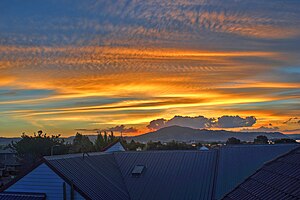Lynmore is a suburb of Rotorua in the Bay of Plenty Region of New Zealand's North Island.
Lynmore | |
|---|---|
 Looking from Lynmore towards Mount Ngongotahā at sunset | |
 | |
| Coordinates: 38°08′37″S 176°17′01″E / 38.143571°S 176.283608°E | |
| Country | New Zealand |
| City | Rotorua |
| Local authority | Rotorua Lakes Council |
| Electoral ward | Te Ipu Wai Auraki General Ward |
| Area | |
| • Land | 220 ha (540 acres) |
| Population (June 2023)[2] | |
| • Total | 3,510 |
| (Lake Rotorua) | Ōwhata | |
| Ngāpuna |
|
|
| Whakarewarewa |
In April 2018, Lynmore had the highest house prices in Rotorua.[3]
Marae edit
The local Apumoana Marae and Apumoana o te Ao Kohatu meeting house is a meeting place for the Tūhourangi hapū of Hurunga Te Rangi, Ngāti Kahupoko, Ngāti Taeotu and Ngāti Tumatawera.[4][5]
Demographics edit
Lynmore covers 2.20 km2 (0.85 sq mi)[1] and had an estimated population of 3,510 as of June 2023,[2] with a population density of 1,595 people per km2.
| Year | Pop. | ±% p.a. |
|---|---|---|
| 2006 | 3,129 | — |
| 2013 | 3,255 | +0.57% |
| 2018 | 3,288 | +0.20% |
| Source: [6] | ||
Before the 2023 census, the suburb had a smaller boundary, covering 1.97 km2 (0.76 sq mi).[1] Using that boundary, Lynmore had a population of 3,288 at the 2018 New Zealand census, an increase of 33 people (1.0%) since the 2013 census, and an increase of 159 people (5.1%) since the 2006 census. There were 1,179 households, comprising 1,596 males and 1,692 females, giving a sex ratio of 0.94 males per female. The median age was 41.7 years (compared with 37.4 years nationally), with 693 people (21.1%) aged under 15 years, 492 (15.0%) aged 15 to 29, 1,590 (48.4%) aged 30 to 64, and 513 (15.6%) aged 65 or older.
Ethnicities were 81.0% European/Pākehā, 16.8% Māori, 2.7% Pacific peoples, 11.9% Asian, and 2.1% other ethnicities. People may identify with more than one ethnicity.
The percentage of people born overseas was 24.5, compared with 27.1% nationally.
Although some people chose not to answer the census's question about religious affiliation, 54.4% had no religion, 34.7% were Christian, 0.4% had Māori religious beliefs, 1.4% were Hindu, 0.6% were Muslim, 0.4% were Buddhist and 2.3% had other religions.
Of those at least 15 years old, 816 (31.4%) people had a bachelor's or higher degree, and 273 (10.5%) people had no formal qualifications. The median income was $41,400, compared with $31,800 nationally. 669 people (25.8%) earned over $70,000 compared to 17.2% nationally. The employment status of those at least 15 was that 1,410 (54.3%) people were employed full-time, 426 (16.4%) were part-time, and 75 (2.9%) were unemployed.[6]
Education edit
Lynmore Primary School is a co-educational state primary school,[7][8] with a roll of 569 as of February 2024.[9]
References edit
- ^ a b c "ArcGIS Web Application". statsnz.maps.arcgis.com. Retrieved 18 April 2024.
- ^ a b "Population estimate tables - NZ.Stat". Statistics New Zealand. Retrieved 25 October 2023.
- ^ Sparks, Zizi. "Lynmore tops house prices as new subdivision announced". New Zealand Media and Entertainment. Rotorua Daily Post.
- ^ "Te Kāhui Māngai directory". tkm.govt.nz. Te Puni Kōkiri.
- ^ "Māori Maps". maorimaps.com. Te Potiki National Trust.
- ^ a b "Statistical area 1 dataset for 2018 Census". Statistics New Zealand. March 2020. Lynmore (201500). 2018 Census place summary: Lynmore
- ^ "Official School Website". lynmore.school.nz.
- ^ "Ministry of Education School Profile". educationcounts.govt.nz. Ministry of Education.
- ^ "Education Review Office Report". ero.govt.nz. Education Review Office.